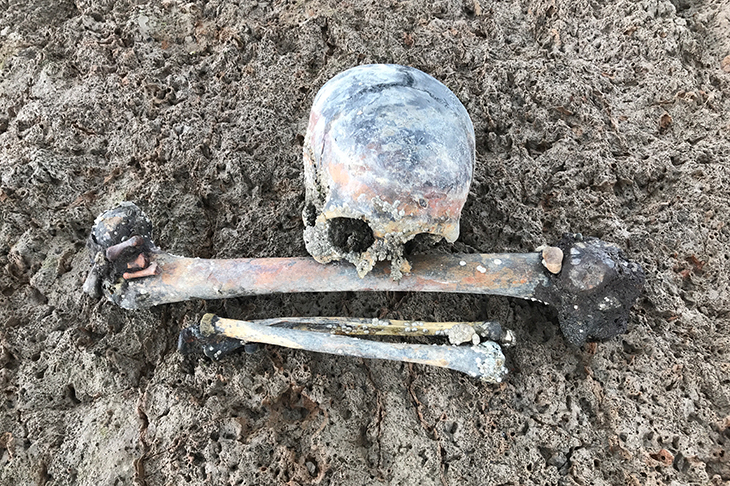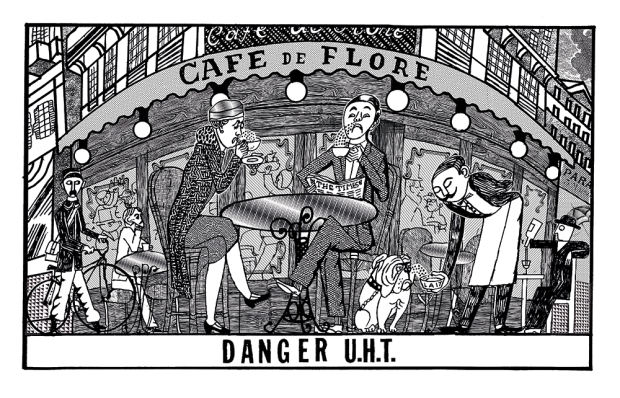If you spend enough time on the Thames, you will eventually come across human remains. It is a river of lost souls, filled with suicides, battles, burials, murders and accidents, with people so poor their families couldn’t afford to bury them, or so destitute they were never missed. Their bones wash up on the foreshore in the drifts of smooth, honey-brown animal bones, the remains of 2,000 years of dining and feasting.
I know this because I am a mudlark and I’ve found my fair share of lost and forgotten Londoners. Mudlarking is best described as a hobby for the archaeologically curious. Twice a day, the tidal Thames falls low enough to search the riverbed for the city’s lost and discarded objects. I let the river dictate what I find; I don’t dig or use a metal detector, I merely take what is left for me on the surface of the mud and caught among the shingle. It is a giant lucky dip, with each tide delivering new treasures and random objects.
In the 15 years I’ve been chasing the tides, I’ve found countless coins and buttons, Roman hairpins, a complete Iron Age pot, medieval buckles, Tudor shoes, Georgian wine bottles and modern wedding rings, but the most sobering are the human finds. A handful of teeth, eaten away by rot, and a dirty creamy-yellow cup, a section of human skull with faint grooves and ridges on the inside where someone’s brain once pressed against it.
Pink rubber gloves, old coats packed with sand, and bedraggled wigs have all stopped me in my tracks over the years, but the grey plastic brick I once found seemed innocent enough, until I picked it up. It was heavier than I expected and when I shook it, it sounded like gravel mixed with sand. I turned it over and saw just enough of a soggy white label to read: ‘Remains of the Late…’ I had found someone’s ashes. What should I do? After much thought, I dropped them back into the river to continue their journey east, even if it meant they would eventually end up permanently marooned further downstream.
People are drawn to the river as a means to an end. I have found two souls that were claimed by its fast-running water and every year the river police recover around 35 bodies, 90 per cent of which are attributed to suicide. If they are not retrieved, tides and currents sweep bodies away quickly, carrying them many miles from where they first entered the water. Some are never found; they are sucked down into the mud or washed out to sea. Those that are recovered are brought back in zipped bags to a riverside mortuary on a floating pontoon in front of Wapping police station. Such is the state of many river corpses that until recently police officers were given a special allowance to search drowned bodies for clues to their identity.
It is unlikely that the bones I and a fellow mudlark found this summer will ever be identified. We were close to the estuary and had just dropped off the shoreline to begin our trudge across miles of sticky grey mud when my friend saw the skull resting upside down in a shallow dip. Winkles had set up home in its crevices and sinuses and a sprig of bladderwrack was growing out of it. A rough skin of barnacles over the rich brown bone showed it had been there some time, and close by we found a single long femur and the two lower bones of an arm. All the rest had been washed away.
There are rules and regulations regarding mudlarking. Anyone searching the foreshore must have a permit from the Port of London Authority (pla.co.uk). Finds of historic note should be recorded on the Portable Antiquities Scheme database (finds.org.uk); anything qualifying as treasure has to be reported by law; and the police must be informed of human remains. We took a GPS reading and called it into the police. The next day the bones were retrieved and delivered to the coroner.
A week or so later a policeman was on my doorstep with a DNA kit. They needed to rule me out of the investigation and assured me that anything they took would be destroyed when it was over, so I submitted to the swab. Meanwhile, my social media pages were buzzing. Through Facebook a specialist in barnacle colonisation of human remains from Murdoch University in Perth, Australia, contacted me. If the bones proved to be as old as I thought, she was keen to get her hands on them for further study.
The bones travelled north to a lab in Scotland where tests confirmed that they are at least 200 years old. It is possible, therefore, that they are those of an inmate from a prison hulk — decommissioned warships that were turned into floating jails to hold Napoleonic prisoners of war and those awaiting transportation. Conditions on board the hulks were horrific — food was scarce and disease was rife. Those who died were treated with little more respect than in life. Their bodies were rowed to nearby marshland and buried in shallow graves next to the river, and it’s not uncommon to find their bones today. Water levels are rising by about a foot every 100 years, eroding their meagre graves.
But it may be possible to give this individual some of the recognition he (or she) was denied in life. I have just heard that the police have agreed to release the bones to Murdoch University, where it hopes to find out as much as possible about the person they belonged to. If there’s a facial reconstruction, I may finally get to look into the face of one of the river’s lost souls.
Got something to add? Join the discussion and comment below.
Get 10 issues for just $10
Subscribe to The Spectator Australia today for the next 10 magazine issues, plus full online access, for just $10.
You might disagree with half of it, but you’ll enjoy reading all of it. Try your first month for free, then just $2 a week for the remainder of your first year.














Comments
Don't miss out
Join the conversation with other Spectator Australia readers. Subscribe to leave a comment.
SUBSCRIBEAlready a subscriber? Log in